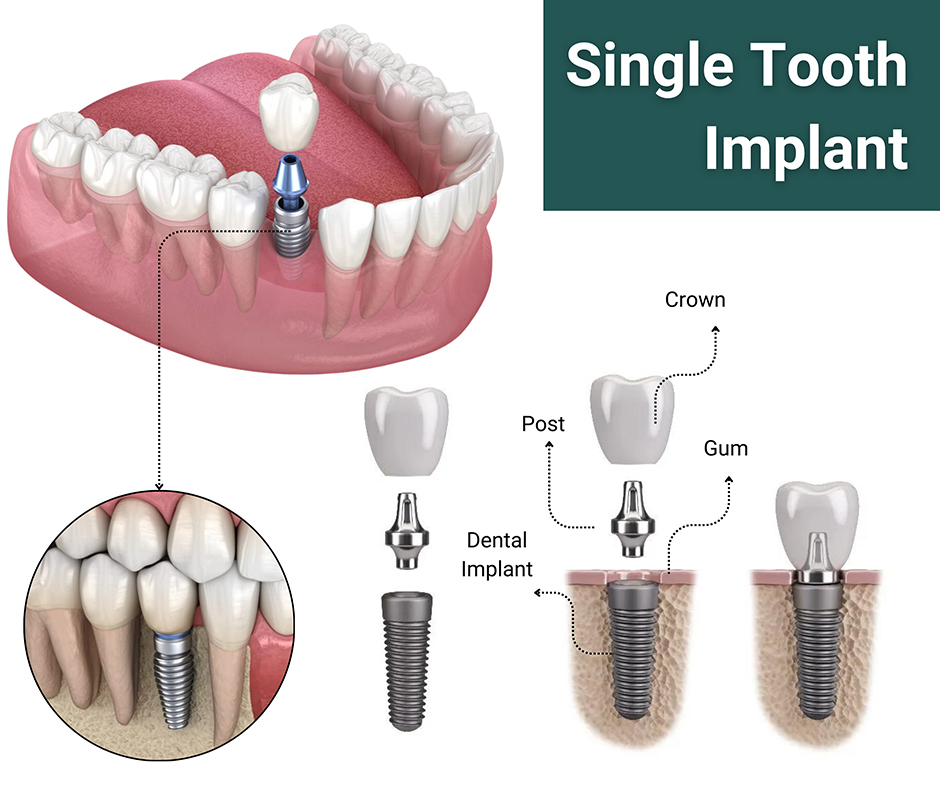Excitement About Dental Implants
Excitement About Dental Implants
Blog Article
The Greatest Guide To Dental Implants
Table of ContentsRumored Buzz on Dental ImplantsThe smart Trick of Dental Implants That Nobody is Talking AboutEverything about Dental ImplantsThe Best Guide To Dental Implants
are clinical tools operatively dental implanted right into the jaw to recover an individual's capability to chew or their appearance. They provide support for artificial (fake) teeth, such as crowns, bridges, or dentures. When a tooth is lost because of injury or condition, an individual can experience complications such as quick bone loss, faulty speech, or modifications to chewing patterns that result in pain.
Framework of The Oral Implant System choosing oral implants, talk to your dental service provider concerning the potential advantages and threats, and whether you are a candidate for the procedure. Points to take into consideration: Your overall health is an important consider establishing whether you are a great candidate for oral implants, for how long it will require to recover, and for how long the dental implant may remain in place.
Smoking may influence the healing process and lower the lasting success of the dental implant. The healing process for the implant body may take numerous months or longer, throughout which time you typically have a temporary abutment instead of the tooth. the oral implant procedure: Very carefully follow the oral hygiene instructions provided to you by your dental provider.
An Unbiased View of Dental Implants
Implant failing can result in the requirement for an additional surgical treatment to deal with or replace the implant system. Brings back the ability to chew Brings back cosmetic appearance Assists keep the jawbone from reducing as a result of bone loss Preserves the health of the bordering bone and periodontals Helps keep adjacent (nearby) teeth secure Improves quality of life Damage to surrounding all-natural teeth throughout dental implant positioning Injury to the surrounding tissues throughout surgery, such as sinus perforation Injury throughout surgery (for example, fracture of surrounding jawbone) Inadequate function, such as really feeling like the teeth do not bite together typically A feeling that the tooth is loosened or twisting in area resulting from an abutment screw loosening Implant body failing (looseness of the implant body) as a result of systemic infection, which may be most likely in individuals with unchecked diabetes due to neighborhood infection in bone and gum tissues sustaining the dental implant body as a result of delayed healing, which may be more probable in patients who smoke Trouble cleaning the gums around the implant, leading to inadequate oral health Unattended gum condition Post-surgical numbness as a result of nerve impingement or damages Constantly notify wellness care providers and imaging professionals that you have oral implants prior to any magnetic vibration imaging (MRI) or x-ray treatments.
FDA is not mindful of any type of adverse events reported for MRI or x-ray procedures with oral implants. Oral implants systems are normally constructed from products that comply with international consensus requirements of the International Organization for Standardization (ISO) or ASTM International. These standards have details of what makes a secure product.
Various other materials such as gold alloys, cobalt-based alloys, titanium alloys, or ceramic materials are often made use of. The security profiles of these products are widely known. Dental dental implant systems are evaluated according to worldwide agreement criteria. Biocompatibility testing, to show that bodily contact with the tool does not cause complications like inflammation or allergic visit this web-site response, belongs to the assessment that helps make certain the materials in the dental implant system are secure and do not trigger unfavorable impacts when implanted in people.

Dental Implants for Dummies
Some individuals are not qualified for oral implant surgical treatment. It is for oral cosmetic surgeons to operate on individuals with: severe illnessuncontrollable metabolic diseasebone or soft tissue disease or infectionIf these issues are fixed, a person can have the surgical treatment. Dental Implants. In, oral cosmetic surgeons avoid operating individuals with: If people with any of the above undertake dental implant surgical procedure, there is a higher threat of the implant failing
Some individuals have a jawbone irregularity that avoids adequate bone for an implant from creating. In such cases, a surgeon may require to execute a ridge alteration. This entails lifting the periodontal to expose the area of flawed bone. The doctor will then utilize a bone or bone alternative to fix and accumulate the area.
Dental dental implant surgery is a customized procedure. Provide you time to heal. Affix the message and last crown, bridge or denture.
Next, your surgeon will very carefully place the dental implant into your jaw. If your dental implant is near the front of your mouth, your dental practitioner will certainly make a short-term over here tooth for you to put on up until you recover.
Rumored Buzz on Dental Implants
Your supplier can tell you what to anticipate in your circumstance. Throughout the healing phase, great site your jawbone should fuse to the oral implant. This process, called osseointegration, is important for stability and long-term success. This process can take anywhere from 3 to nine months. In many cases, it may take much longer.
When your implant heals, your dental professional can attach the abutment (little port message) and your final repair (crown, bridge or denture). This generally takes about one hour to complete and may require a second small surgical procedure. You should not feel any pain throughout your dental implant treatment due to the fact that your company will utilize drug to numb your gums.
Report this page